Hello dear readers! I hope you have had a great summer (so far). Scorching at least. Have you seen the coronal hole on the northern hemisphere of the Sun on 2 August? (Look at me, dad! I’m doing small talk!)
This post will not be about autism specifically, but rather a post on the life of two autistic people, and an explanation for our absence online. I will not discuss autism research in this post, so if that is what you are here for, this post is probably not for you!
Absence
Natalie and I have been less active in the last months, and as you might have noticed, we haven’t published anything on Embrace ASD for more than a month. This is because we found ourselves getting buried in responsibilities, including heaps of taxes to process, as well as filing receipts in their respective folders. Some might argue that is the autistic dream, and indeed, I did have fun coming up with the different categories to file the different receipts under, and write the names of the categories onto the plastic folders, using different colors for different classes of categories. Oh I can tell you more about my ontological considerations, but let’s not be dramatic. Although I did find some things to appreciate in the hard labor in collaboration with Natalie, we both dreaded the sheer amount of towering workload that lay before us, and so we often put it off.
Now and then we had this intense motivation to get it done, work for hours, be happy with the amount of work we got done and promising each other we will continue the work next day, but by next day the motivation would be gone, and we would put it off. We were never not working, however; there was always work to do, but getting the taxes done was honestly one of the highest priorities, even though we didn’t quite treat it that way. We prolonged this struggle for months, and prolonged our anxiety along with it. But Sisyphean as the tax project seemed, we ultimately prevailed and got it done! Yay!
Were we finally absolved of our responsibilities? Of course not!
We had to fill in a lot of forms and send documents to complete the immigration process. For those who don’t know, I moved from the Netherlands to Canada a bit over a year ago to live with Natalie. We recently sent in the last documents, and are now waiting to hear back about whether I can stay in Canada. We will still have to do some interviews, and I will get my English proficiency tested, but the things that terrified us most are done!
Hey, and I said I would not present autism research here, but if you know me, you know it’s nigh-impossible for me not to mention any research. If you are autistic yourself, you might know how terrifying paperwork can be. But did you know it is one of the things that can cause us PTSD? Research from 2017 by N Haruvi-Lamdan, Danny Horesh, and Ofer Golan indicates the following:
Abuse, sexual assault, violence, natural disasters and wartime combat are all common causes of PTSD in the general population.
Among autistic people, though, less extreme experiences—fire alarms, paperwork, the loss of a family pet, even a stranger’s offhand comment—can also be destabilizing. They can also be traumatized by others’ behavior toward them.[1]PTSD and Autism Spectrum Disorder: Co-morbidity, Gaps in Research and Potential Shared Mechanisms
I don’t know if I have PTSD from paperwork, but it does stress me out a lot. I did acquire PTSD from email correspondence 8 years ago. I am only starting to get better with emails since last year. Fortunately, Natalie did most of the paperwork and correspondence with our lawyers, while I had an assistive role, which involved scanning signed documents and filing them.
If you are interested to learn more about what autistic people can get PTSD from—and why—have a look at our post on autism and PTSD:
The link between autism & PTSD
The garden
So why is this post called ‘Garden Construction’? Because the garden has been our latest MAJOR project, and the reason we haven’t posted anything for a month.
Weeks ago, Natalie’s assistant told us we need to address the garden, because patients were talking about the sad state of our front garden. The lawn had to be mowed. We got an electric lawn mower, and as silent as it is, it is actually pretty cool to maw the lawn. Look at me, dad! I am being an adult!
We also have a foresty back garden, which Natalie and I honestly thought was perfect the way it was, but Natalie’s assistant disagreed, and insisted it was unruly. After having mown the lawn though, I started noticing other things in the garden—the front, back, and side garden—that needed to be addressed, and in the following days I filled 7 large garden bags with plant material. Seven!
Then, our neighbors from two doors down (let’s call them Lilly and Dale) got involved, and things started escalating quickly. I honestly don’t remember how it started, but they offered to help us out in the garden to make the front of Natalie’s clinic look great. What I did not expect was that Lilly would come over every day to work with me for hours on end (and on some days Dale would also help after his day job), while Natalie was away on a trip to Montreal with her son for 6 days. And speaking of 6, that is the number of hours we would put into that garden every day! On day 2 my muscles were very sore. On day 4 they were mush. On day 5 I felt I had to be careful with lifting things, because I felt I could tear my biceps (I tore a muscle before).
We moved a lot of plants, cut down branches of trees, and so forth. We did our best to make everything look great before Natalie returned, and days later, we managed to fill another 14 garden bags. You should have seen the garden bags-based wall I built on the sidewalk before they were picked up!
At the end of the week, Natalie came back from her trip, and was amazed by the amount of work we did. We did make the front garden look beautiful. I was proud of the work we did and the results, but to my dismay, Lilly and Dale were already making plans for next year to properly address the foresty back garden. I mean, it’s amazing how much they helped us, but being autistic, I also felt it was a lot to handle. I had a few meltdowns along the way. At least we would have autumn and winter to ourselves, right?
But the story doesn’t end there. Dale walked to the back of the house to inspect our deck up close, and immediately declared it to be a deathtrap which had to be addressed as soon as possible. He offered to help us build it. And good news—he said—because Dale starts his vacation upcoming Friday, so he can come over every day now! Jolly!
The deck
Coming by every day he did. For a week, Dale and Lilly have been showing up every morning at 8 to build the deck, while Natalie and I worked on the garden. Natalie went back to work in the clinic on Tuesday last week (not last Tuesday), so it has been mostly the three of us since then.
We work from 8 to 3 pm, at which point Lilly and Dale usually go home to rest and nap. After dinner, they come back and work until it’s too dark to keep going. We usually finish working at 10 pm. I sometimes continued working in the garden while they went home, because it’s not always easy for me to leave work undone. While they are gone, I would cut up all the branches we took off the trees and stuff it all in bags. Content with how much vegetation is now gone, the next day we cut more branches, and it’s like I never cleaned up anything! Gardening seems like an endless exercise. And truly, from a cosmic perspective, it’s utterly futile! Not only will the garden grow right back, but I imagine many generations after me will invest many hours of work into keeping that garden, and for what? For a temporary perception of order, of course. But that damn entropy keeps coming back!
It’s astounding how much time you can invest in a garden, but it’s also quite impressive what we got done. Really, we were just a decade behind with many things in the garden, which is quite astounding because Natalie has been paying a gardener every week, but I honestly have no clue what he actually did. He stopped showing up at some point, which is just as well, because I must say I do a much better job. I am meticulous in everything I do. And yes, it almost seems like gardening has become my special interest. But I assure you, it’s more of a compulsion than a passion. I do like the fact that I am physically active, however, and I very much enjoy the results of our labor.
Also, during this horticultural project, I have been wearing my Fitbit tracker—like I always do—and according to the thing I am supposed to take 10,000 steps each day. Last year during my most active period, I would frequently get 12,000 steps and be very proud of myself.
But for all that time walking, I should have just done some gardening! Every day, I easily make it past 10,000 steps around noon, and reach around 27,000 steps at the end of the day. I lost 4 kg in a week!
Anyway, look at how awesome our deck has become!

The neighbors
Natalie and I have wondered why the neighbors would come over to help us—and in particular, help us to this degree. We have been friendly with them, but we are—or were at this point—not friends.
Natalie has lived here for over 27 years, without much of any contact with neighbors. Since I moved here last year, however, the neighborhood has gotten to know us! I don’t know why, but I seem to attract people, which is perhaps not the greatest thing for an autistic person with questionable social skills! I have to be social though; when neighbors engage you, you try to remain socially appropriate and ask about them. Meanwhile, you pray to the gods that the amount of small talk is sufficient now, and you can get on with matters that actually, you know, matter to you.
Anyway, the more I try to be socially appropriate, the more it’s being mistaken for being social. I guess there isn’t necessarily a distinction. The point is that I am being social to be appropriate, rather than being social because I derive pleasure from it. Either way, people seem to like me. Back in the Netherlands, I would consciously avoid greeting anyone in the neighborhood, because if you do it once, they start expecting it.
But here we are. It’s too late now. Look at me, dad! I am reluctantly being an adult!
Anyway, part of the reason I think the neighbors have been helping us so much is that Lilly felt our garden had a lot of potential, due in part to its size. Her front garden looks fantastic, but it’s relatively small. By working on our garden, she could bring some of her fantasies about our garden—accumulated for over two decades—into reality. At least, that was one of the theories I came up with to explain why they were helping us.
But also, they are just really kind people. Even though they are on vacation, I have seen they are helping quite a few people. I think that is just what they tend to do, hoping that other people will also have their back. They also highly value ethics and honesty. If it weren’t for how social they are, I would think they might be autistic. Maybe they are! It’s hard to tell sometimes.
Husks
While cleaning the leaves out of the inside of a basement window, I found what I thought to be a beetle husk.
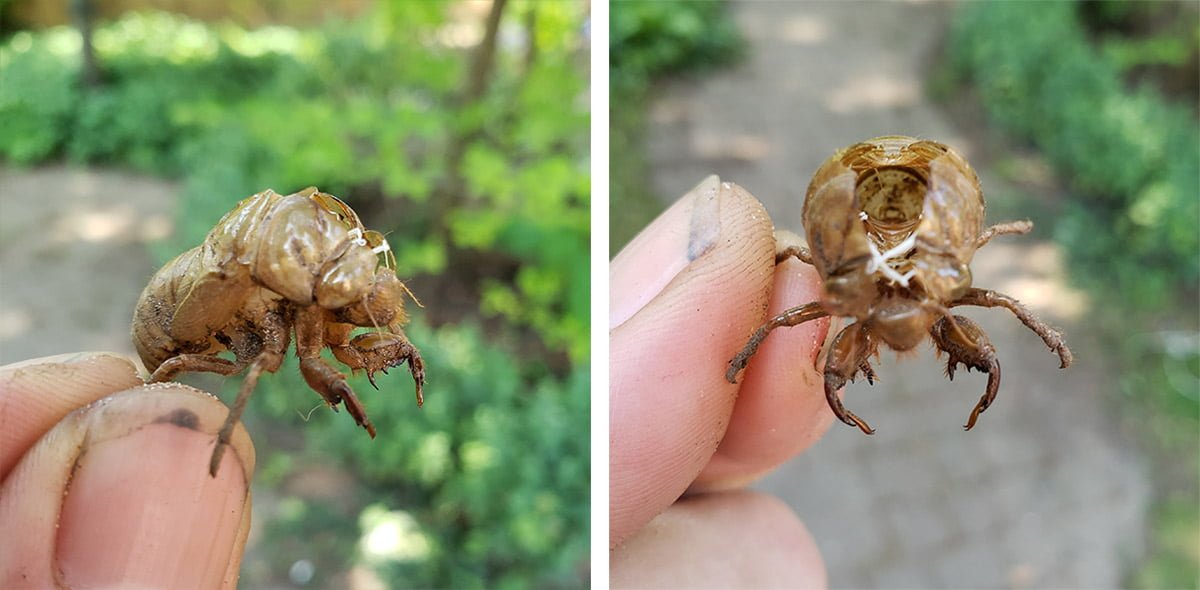
That same day, Sonya Hallett—an autistic illustrator, graphic designer, and all-round creative person (check out Sonya’s website to see their fantastic work)–posted this cool Lego beetle she made on Twitter. I thought there was a resemblance to my beetle husk.
I made a cute lego beetle. pic.twitter.com/InkOfFqKCk
— Sonny (@scrappapertiger) July 23, 2019
Sonya told me that beetles don’t shed their exoskeleton, and that what I had there was a Cicada husk. Very cool! We hear them around the house a lot, but I didn’t recognize this husk to be a cicada. In fact, I did not know they leave husks behind!
A few days later, I found another husk. The cicada clawed itself into the net walls of our gazeebo; once firmly attached to the net, it climbed out of its husk through the back. Really impressive.
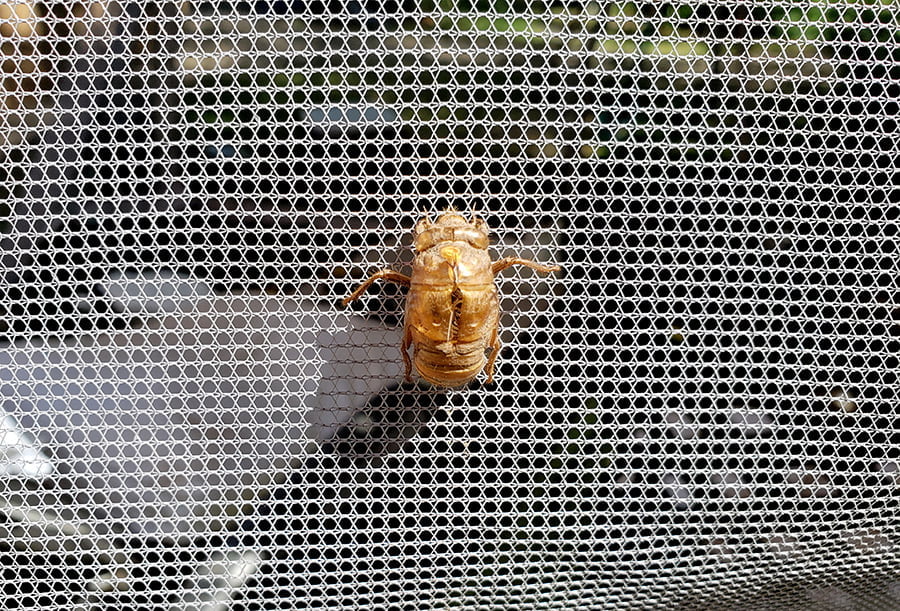
A few days later I found four more husks firmly attached to our picket fence, and another one under a tree. Now I had 7 Cicada husks in total! Natalie suggested we paint them and create a Cicada circus. I’m not entirely sure what that means, but as I wanted to take a picture of all my husks, I accidentally broke off some limbs of one of the husks (they become quite fragile when dried out), which gave me an idea for a pose:
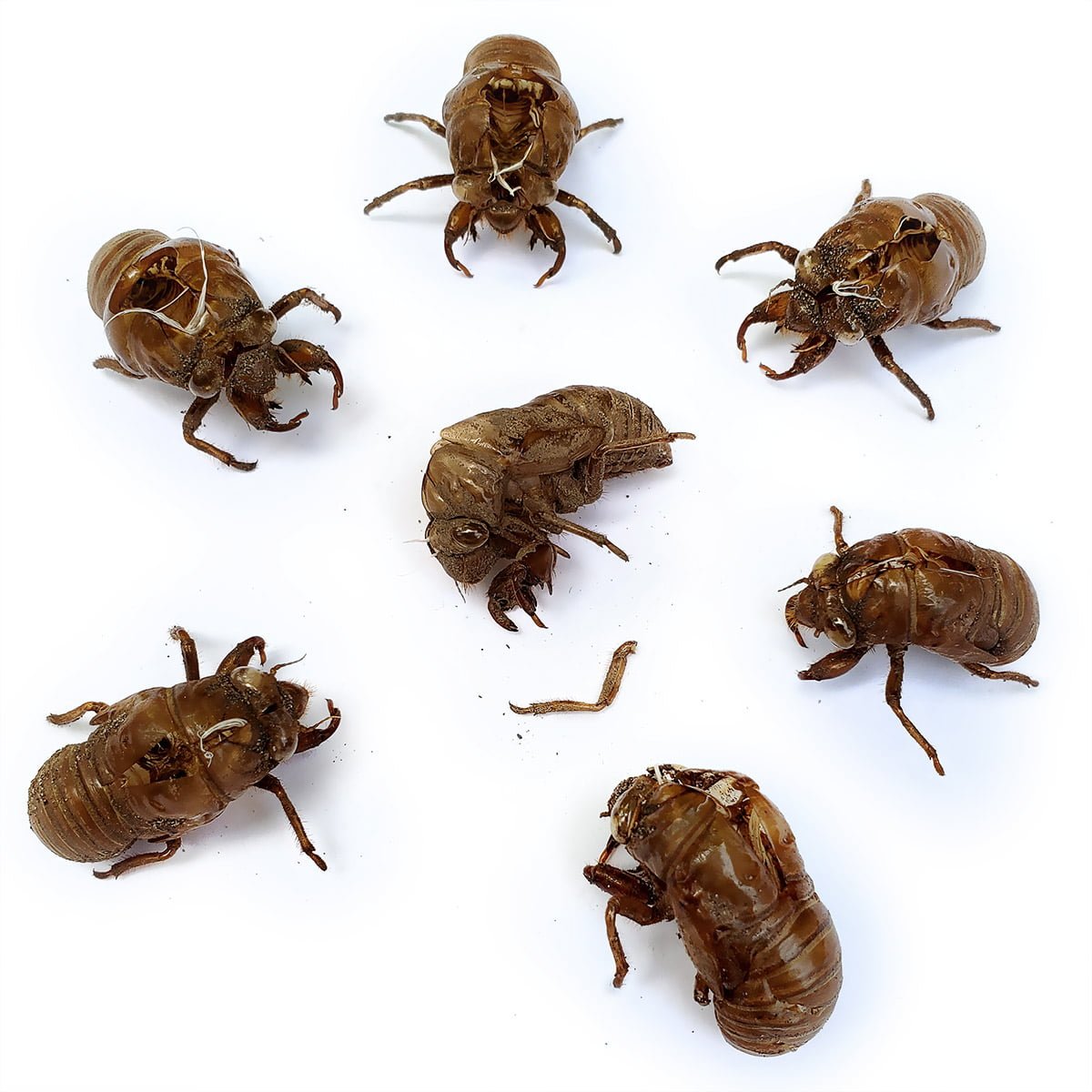
And what do you think of this dramatic shot?
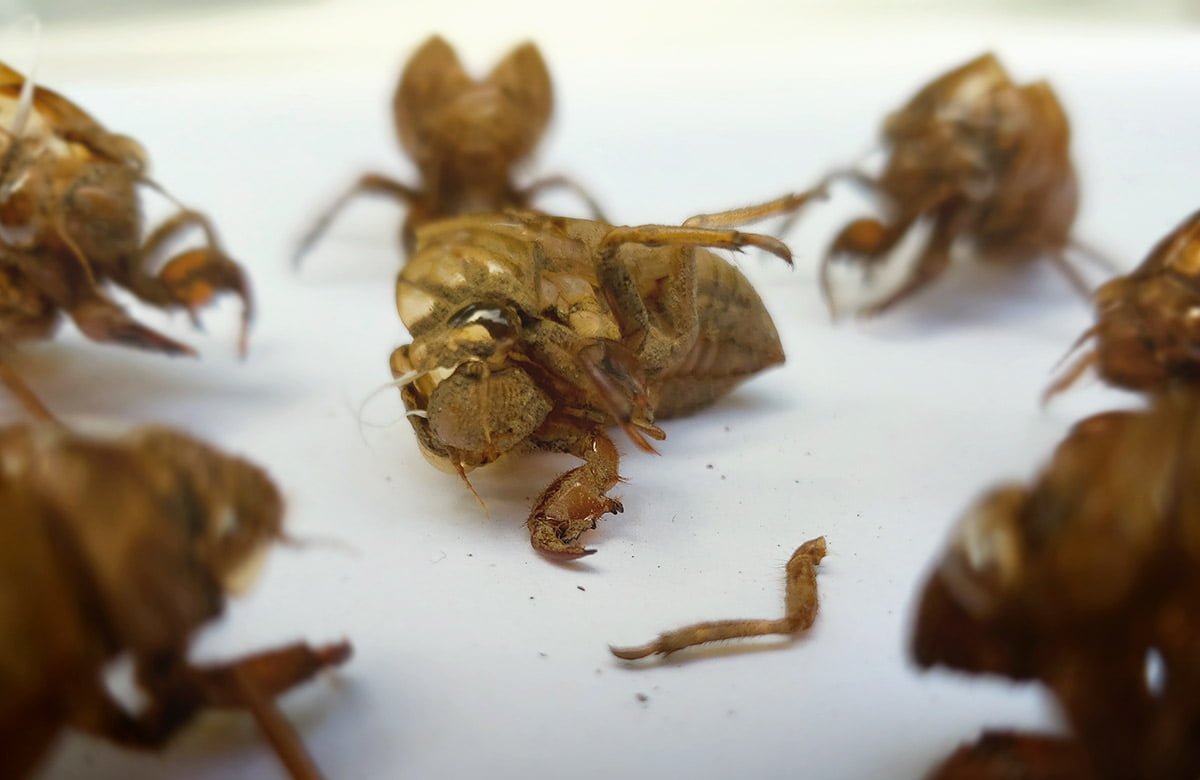
I just realized, if I were to do this with human skins, placing them in a particular configuration to tell a particular story, suddenly it’s all controversial! It’s speciesism, really.
The corpse
Oh, here is something *fascinating* we found while digging in our garden. Natalie found a tooth! It looked like a molar tooth. I got really excited! If there is a tooth, there very well might be a body! Natalie didn’t appreciate the idea, and was not enthused about the likelihood of there being a body in our garden like I was.
I was digging out roots, but now the possibility of a body urged me to dig a little deeper. I joked to Natalie how, if we find a human body, the police will dig most of the roots out for us! We should really see this as a positive. I joked that the first owner of our house (which was built around 1870) might have been a serial killer. Many of the historic houses in Oakville where we live feature signs that mention the name of the original owner and their profession. For example, 7 houses down is a house by a certain William Dent who was a carpenter. You can request one of those signs from the town officials, and we have been meaning to pursue that and find out who owned our house. But now, maybe our sign is going to say something like John Birch, serial killer? The butcher of Oakville? Perhaps never mind about that sign.
I was laughing, amused by my own jokes. Natalie laughed as well, but was clearly also concerned.
Each time I dug and hit something hard with my spade, I got excited and thought, “This might be it! It’s a skull!” But alas, all I found were roots. We never found a body, but to be honest I also didn’t dig very deep. There were so many roots that it would have taken me hours to dig to a considerable depth, and Natalie wasn’t even sure where exactly she found the tooth in the first place.
Later when Natalie’s son came over, we showed him the tooth, and he recognized it to be a canine tooth. He showed Natalie a picture of a canine molar, and indeed that seemed to be it. So maybe one of the previous owners buried their pet in their garden?
That’s kind of the curious thing about owning a garden; you don’t know who owned that land and what they did with it. If you dig long enough, you might find mythical gold, an underground bunker, or a dog. You don’t know until you dig.
So yeah, we might have a canine corpse in our garden. What kind of graveyard might your garden be?
If you prefer to read about dogs that are still alive, consider reading the following post:
A failed interaction with a dog
Disposal
So the garden-and-deck project has been going on, and we filled another 20 garden bags!
Yet we still had our old deck to get rid of, as well as many large tree branches which we stacked into two large piles on our driveway. It seemed silly to try to cut up all the branches and put them in bags, and it would be crazy to cut up all the wood of the old deck to fit it all into who knows how many more bags. So instead, we rented a large bin that can carry 2 tons or more. Our lives are a lot easier now!
Are they though? Of course not! We decided, since we have such a large bin now anyway, we best make full use of it and address our basement. So for a week now, we have also been cleaning out our basement—including a dresser containing at least one dead rat, which made the bin smell like death until it rained one time. I’m not sure why the rain would have helped, so perhaps the rain was only incidental, and an animal took the body out of the dresser. Thank God for scavenging neighborhood animals.
I have another amusing anecdote about the bin. The first thing I put in it—before we even started doing any basement-related things—was the old deck. Dale warned me that the rusty nails can be very dangerous if they pierce my skin and the rust gets into my cardiovascular system, so he urged me to put the planks into the bin one by one. I suppose being autistic, I followed his instructions exactly, and meticulously stacked all the pieces of wood against the back and sides of the bin, with the nails facing down. When he looked into the bin the next day, he told me I did a great job. I was happy to hear that, but didn’t think much of his comment. Later that day, Natalie told me that Dale said he had never seen anyone fill a bin so meticulously, and asked if that is what autism is. I would say it’s probably a big part of it. Whatever I do, I want to do it right.
But also, I thought the way I stacked all the wood was exactly what Dale told me to do and nothing more. So it’s unclear to me whether the meticulous work or the literal interpretation is more characteristic of autism.
Wisdom
Actually, our lives *have* gotten easier. Indeed, renting the container initially caused stress as we were now cleaning the basement as well as doing our garden—as well as various repairs on the house by electricians and brick workers—and this stress contributed to both Natalie and myself having meltdowns one day (me in the morning, and Natalie later in the day).
But we also learned some valuable lessons. One of the most important ones is to take it easy, and take the necessary rest. Yes, it will make us feel better to get a lot of work done and use the bin in an efficient, cost-effective way, but this should not come at the cost of our mental and physical health. As such, we should approach whatever we do with a mindful attitude.
Dale offered an excellent anecdote that really exemplifies what I am talking about. He explained how it took him and Lilly 4 years to make their garden look the way it does now, but they enjoyed all of it because they took the rest they needed and wanted, and didn’t push themselves to get it done as fast as possible at the cost of their health. Now, thinking back at everything they did, they feel nostalgic. Not only do they feel satisfied with all the work they did, but they created happy memories. That is infinitely much better than getting stressed out to get things done as fast as possible, be in agitated states, use tone with each other, etc.
That was a really valuable lesson for us. And so rather than stressing about getting the basement clean in time before the bin is going to be picked up, we decided to rent it for another week, and have all the time we need to finish the project with enjoyment. And speaking of enjoyment, last week we bought solar lamps, and we love the look of our garden at night:
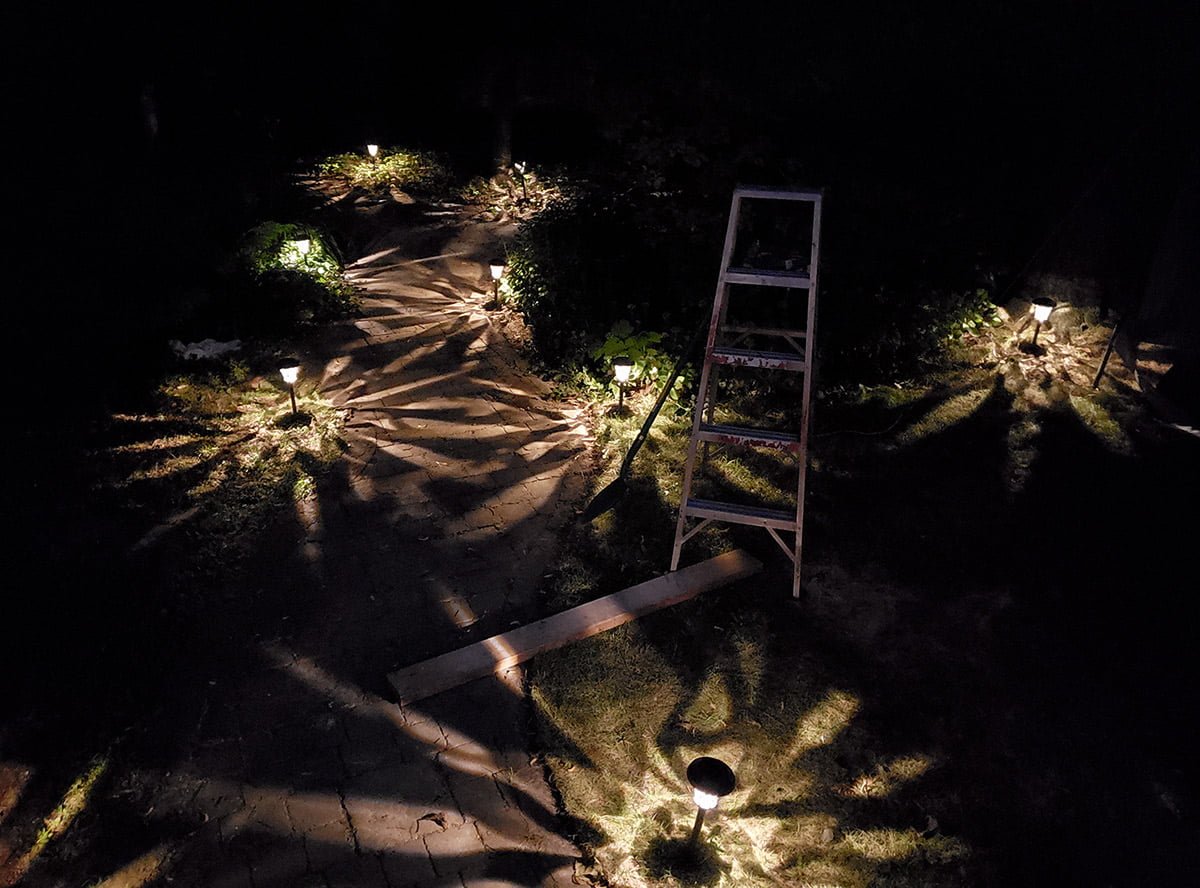
Indeed we have been feeling much better, in part due to being more mindful, but also because we are actively working at getting our lives more organized, and we are exponentially increasing our enjoyment of our living environment.
There is something interesting about the relationship between us and our environments; your living environment is a reflection of your psyche in the sense that a more disordered and disorganized mind is not generally able to impose order and organization on its environment, and so generally you will find a correlation between the state of someone’s mind and their living space. The state of your environment, in turn, influences your psyche as well, so a disorganized environment can undermine the psyche’s attempts to self-organize. So if you feel bad and disordered, your living space will likely reflect that, and your living space will sustain that in you; whereas if you feel well and organized, your living space will likely reflect that too, and it will have a positive effect on your psyche. Obviously, we all feel better living in a clean and organized environment.
So whether we felt better since we started cleaning the basement, or we started feeling better because we are starting to get the basement clean, it’s a bit like the chicken or the egg causality dilemma. Whichever came first is not really important. Yes, a prerequisite for cleaning up the basement is that we felt good enough to do it, but since we are addressing the chaotic state of the basement—and not overstressing ourselves doing it—we are now engaged in an upward spiral of feeling good.
On the downside, then, soon enough the basement is clean, and we will then require a new project to get our dopamine fix and sustain our new addiction. I guess this is part of what it means to be autistic.
And another lesson to learn from this is that if you want to make an autistic person feel good, perhaps give them a compliment, followed by the demand to clean your basement. The compliment might give enough dopamine to act as the spark that ignites and drives the autism engine until the job is done. After that, give the autistic person another job, and pay them well (with money—not just dopamine).
Embrace ASD projects
Speaking of new projects, we are currently working on a few exciting things, including expanding our team with more awesome autistic people, and an ominous project that has something to do with robots. We will tell you all about it in future posts. Unrelated to Embrace ASD, but in the last month I have also done some freelance design work for Jet Propulsion Laboratory(!), which is a dream come true given my affinity for astronomy. I am not allowed to show anything yet, but when I am allowed I might post some of my work here if there is interest.
Also, we are working on several new and (arguably) interesting and fun posts, so come have another look at our website soon, because we have officially returned!
Comments
Let us know what you think!